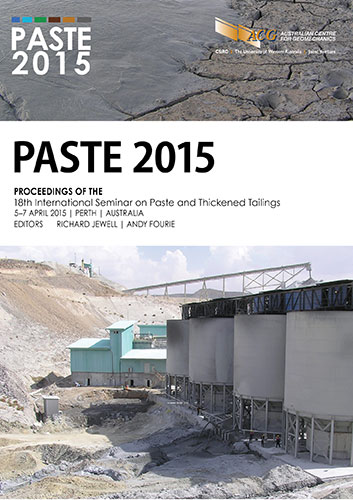Optimisation and stabilisation of coal rejects at the Peabody Metropolitan Mine using Acti-Gel® 208

|
Authors: Worsley, JH; Marsh, JE; Patel, R; Feldman, SB Paper is not available for download Contact Us |
DOI https://doi.org/10.36487/ACG_rep/1504_23_Marsh
Cite As:
Worsley, JH, Marsh, JE, Patel, R & Feldman, SB 2015, 'Optimisation and stabilisation of coal rejects at the Peabody Metropolitan Mine using Acti-Gel® 208', in R Jewell & AB Fourie (eds), Paste 2015: Proceedings of the 18th International Seminar on Paste and Thickened Tailings, Australian Centre for Geomechanics, Perth, pp. 309-319, https://doi.org/10.36487/ACG_rep/1504_23_Marsh
Abstract:
The Peabody Energy Metropolitan Mine in New South Wales produces about two million tons of metallurgical-grade coal annually through an underground longwall mining operation, producing about 450 ktpa of coarse-grained rejects and ultra-fine tailings that require co-disposal. Currently, ~100 ktpa of these materials are processed to form high-density slurry that is pumped up to 2 km as backfill into underground voids. The balance of the waste is trucked and dumped, but the mine has a mandate to pump 100% of the rejects underground by the end of 2015 and to extend the pumping distance to at least 7 km. We conducted field trials to optimise and stabilise the slurry using Acti-Gel® 208, a highly-purified Mg-aluminosilicate rheology modifier and suspending agent, at the Metropolitan Mine using the 100 mm NB pipe loop connected to the backfill pilot plant. Coal rejects used for the demonstration were comprised of a typical mix of ultra-fine, fine and coarse particles ranging to ~15 mm with the percent solids and process water adjusted to a target range of between 74-76% and a starting yield point of at least 100 Pa. To determine how the treatment affected the properties of each mix, baseline pipeline pressure data was collected for a period of about two hours prior to adding Acti-Gel. Slurry samples were taken at regular intervals thereafter to measure yield stress, specific gravity and other parameters in both treated and untreated mixes. Pumping tests were also conducted by varying the flow rate of each mix through the pipe loop from about 0.2-2.0 m/s and by ramping pump speed up and down with 15 minutes of stable operation at each speed in order to obtain pipeline pressure data. In contrast to the control mix, slurry treated with Acti-Gel showed non-settling suspension behaviour and yield point stability at or above the 100 Pa target for the duration of the two-hour pipe loop operation. A simulated unplanned stoppage test confirmed that the Acti-Gel slurry maintained the 100 Pa yield stress, enabling a smooth restart after 14 hours. Pressure drop data also showed that Acti-Gel decreased pressure loss by about 15% as compared to an untreated mix. This provides an important benefit in extending the pumping distance and reducing pipeline wear. Additional results of Acti-Gel rheological behaviour in slurry and backfill systems will be presented.
References:
Bouras, R, Chaouche, M, & Kaci, S 2008, ‘Influence of viscosity-modifying admixtures on the thixotropic behaviour of cement pastes’, Applied Rheology, vol. 18, no. 4, pp. 456041-456048.
Jewell, RJ, Fourie, AB & Lord, ER 2002, Paste and thickened tailings: a guide, Australian Centre for Geomechanics, Perth.
Jolin, M, Burns, D, Bissonnette, B, Gagnon, F & Bolduc, L 2009, ‘Understanding the pumpability of concrete’, in F Amberg &
KF Garshol (eds), Proceedings of Shotcrete for Underground Support xi, Engineering Conferences International, New York, viewed
17 February 2015, .
Kawashima, S, Chaouche, M, Corr, DJ, & Shar, S 2013, ‘Rate of thixotropic rebuilding of cement pastes modified with highly purified attapulgite clays’, Cement and Concrete Research, vol. 53, pp. 112-118.
© Copyright 2025, Australian Centre for Geomechanics (ACG), The University of Western Australia. All rights reserved.
View copyright/legal information
Please direct any queries or error reports to repository-acg@uwa.edu.au
View copyright/legal information
Please direct any queries or error reports to repository-acg@uwa.edu.au